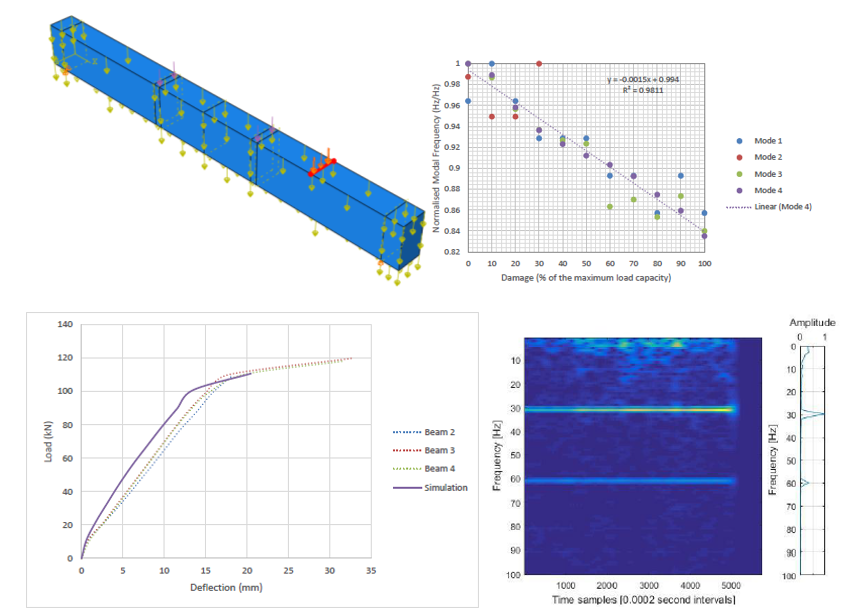Research
Research Interests
- Damage assessment using acoustic emission
- Flexural/shear retrofitting in RC beams using CFRP material
- Pattern recognition using numerical methods
Projects
- 2022-2023 | Funding agency: Korea National University of Transportation, South Korea
- Project Progress
- FE modeling of horizontal precast concrete wall-slab join
- Parametric study on variables like wall confinement, relative concrete strengths and joint bearing
- Current design code evaluation for horizontal wedge-type joints
Project Details (click to expand)
Project Summary:
Publication:
Muhammad Usman Hanif, Soo-Yeon Seo, and Muhammad Fawad. “Numerical study on the design performance of wedge-type precast horizontal wall-slab joint for vertical load transfer.” Structures (2024): 60.
Simulation:
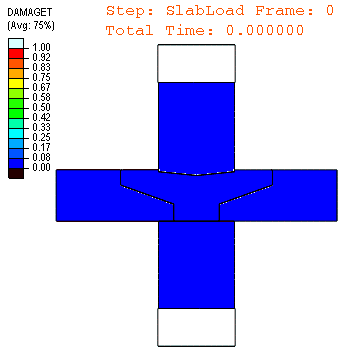
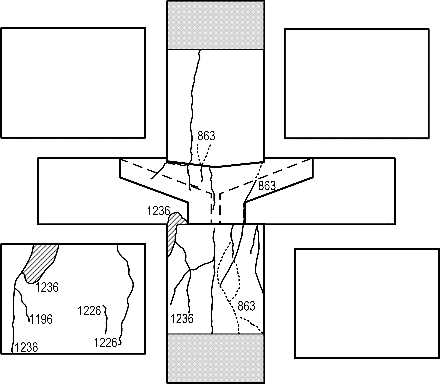
- 2023-2025 | Funding agency: National Research Program for Universities (NRPU), Higher Education Commission Pakistan
- Project Progress
- Dr. Athar Ali (PI)
- Dr. M. Usman Hanif (Co-PI)
- Dr. M. Usman Hassan (Co-PI)
- Janita Mahnoor Shahid (MSc Structural Engineering)
- Hamza Ahsan Abdullah (MSc Structural Engineering)
- Development of a testbed for Structural Health Monitoring of RC Bridges
- Sensor development for health monitoring of RC bridges
- Procedure development of real-time monitoring
- Finite Element Modeling of Prototype Bridge for Structural Identification and System Characterization
Project Details (click to expand)
Project Team:
Graduate Students:
Project Summary:
Methodology:
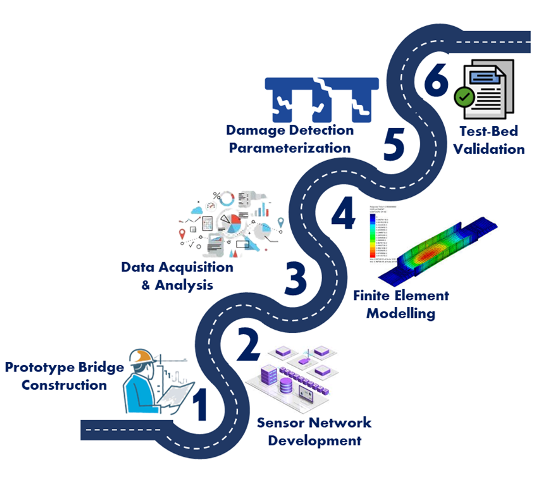
Test Schematics:
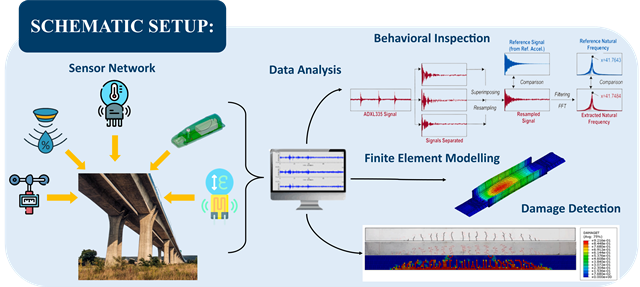
- 2022 | Funding agency: Pakistan Poverty Alleviation Fund (PPAF), Pakistan
- Progress (completed)
- Dr. M. Usman Hanif (PI)
- Engr. Arsalan Mushtaq (Collaborator)
- Farooq Ahmed Athar (Undergraduate student)
- Revising the existing design provisions in accordance with the building codes
- Simplify the design and provide design charts easily interpretable by the community
Project Details (click to expand)
Project Team:
Students involved:
Project Summary:
Finished Manual:
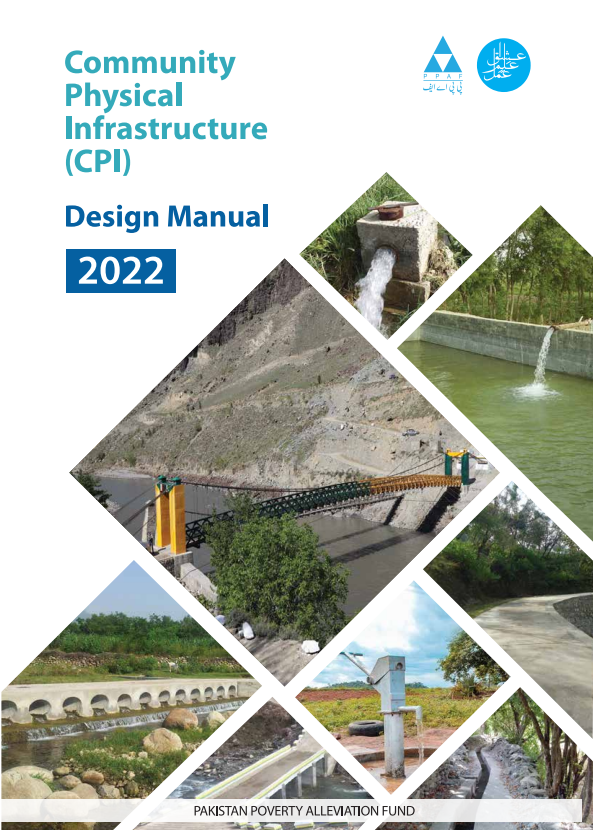
Collaborators
Dr. M Usman Hassan
Assistant Professor, NUST Pakistan
Signal Processing | Data Analysis
Dr. Athar Ali
Assistant Professor, NUST Pakistan
FE Modeling | Retrofitting
Dr. Khaled Ghaedi
CEO, Pasofal Engineering Group Malaysia
FE modeling | constitutive modeling
Dr. Ahad Javanmardi
Associate Professor, Fuzhou University China
FE Modeling | Mechanics
Atif Ahmed
Tech Lead, INTEL Malaysia
Programming | Data Analysis
Dr. Ahmad Zaki
Assistant Professor, UMY Indonesia
RC modeling | Materials
Research Dissertations
Graduate Research
2022 - Damage assessment of RC structures using cost-effective MEMS accelerometers
MS Student: Sultani Mulk Khan
Abstract: Acquisition of vibration data using off-the-shelf equipment is a costly procedure, thus constraining the research and development in developing countries. In this research, micro-electromechanical systems (MEMS) accelerometers combined with an Arduino-based data acquisition system, were used to acquire vibration data of a reinforced concrete beam at various damage levels. The recorded data, having lower and varying sampling frequency, were processed to find the fundamental frequency of the beam. The results showed good agreement with the commercially available accelerometers. To integrate the experimental and computational work, a finite element model was developed which showed good agreement with the experiment. It was found that MEMS accelerometers are cost-effective and can be effectively employed for continuous health monitoring of existing civil infrastructure.
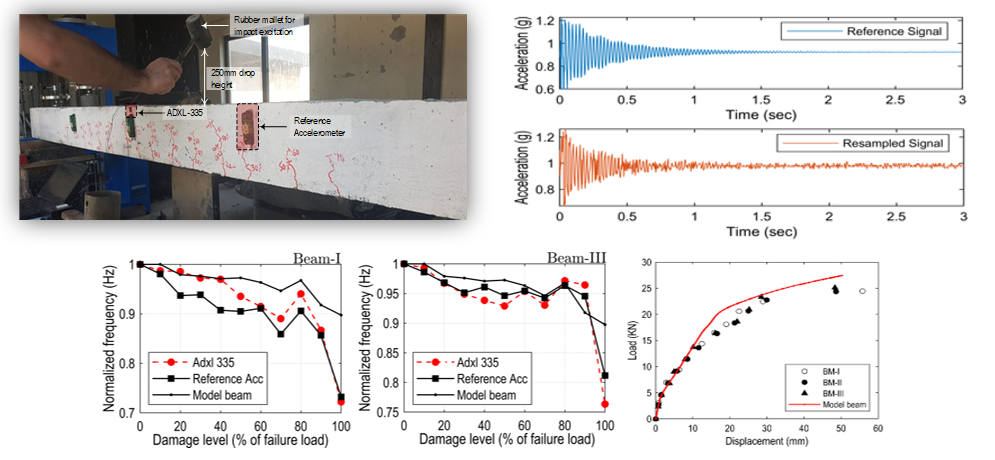
2020 - Damage assessment of reinforced concrete beams based on plasticity approach
MS Student: Abdul Rehman Shafiq Mughal
Abstract: All structures, as well as crucial civil infrastructure facilities like bridges and highways, deteriorate with time because of varied reasons as well as fatigue failure caused by repetitive traffic masses, effects of environmental conditions, associated extreme events like an earthquake. This needs not simply routine or critical-event based mostly inspections (such as associate earth-quake), however a means of continuous monitoring of a structure to provide an assessment of changes as a function of time and an early warning of an unsafe condition using real-time data. Thus, the health watching of structures has been a hot analysis topic of structural engineering in recent years. Therefore, there is a need to develop a damage detection method which can identify most of the damages in RC structures. The main objective of this research is to model and simulate damage in RC beam with the aid of finite element software, ABAQUS. In order to achieve this goal, material modelling was carried out. Concrete Damaged Plasticity (CDP) model was used to simulate failure of concrete beams. Static and dynamic analysis were simulated with the aid of ABAQUS. The validation of the numerical model was made through literature data, including static and dynamic testing of RC beams. The relationships between load and deflection, damage level and natural frequency were discussed. The comparison between the results of the numerical model from ABAQUS and literature data showed a similar trend in deflection and damage levels. Furthermore, an insight on non-linearities as damage indicators has been simulated. These damage indicators have been simulated and experimentally proved and have promising prospects in damage detection of structures without the need of baseline data. The research requires to be extended to identifying more non-linear characteristics.
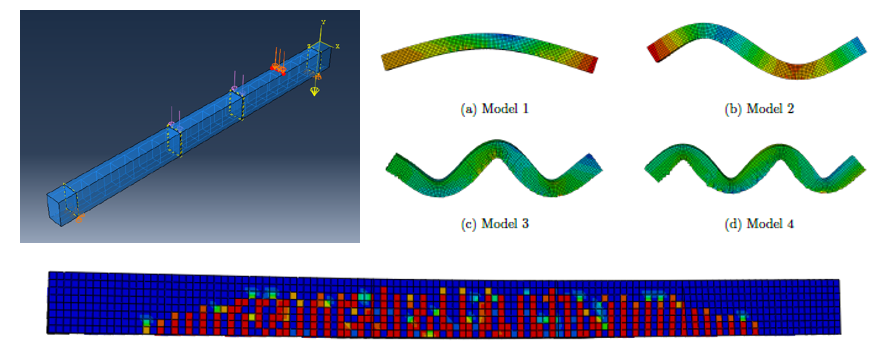
Undergraduate Research
2022 - Investigating damage in reinforced concrete members using a vibrating wire strain gauge
Authors: Hussain Ahmad Sheikh, Sadam Hussain, Asad Nadeem, Muhammad Usman
Abstract: Recently the use of vibrating wire strain gauges has increased to find out the damage in a reinforced concrete structure. The assembly and functioning of this acoustic strain gauge are presented. This gauge provides numerous benefits including its sensitivity to measure strain (up to 1micron) and its property of being easily attached on any concrete surface. The gauge apparatus can be made in a lab due to its low cost which gives it an edge over the conventional systems. The gauge was calibrated after considering the variations in temperature. The purpose of the experimentation was to record the changes in nonlinear vibrations with respect to the damage caused in the reinforced concrete member. These changes were later studied using the vibration tests on the reinforced concrete beam. Nonlinearities were observed by the changes in the fundamental frequency. Discrete Fourier transforms moving window was utilized to analyze the vibration signals specifically the change in frequency with respect to time. The results are presented and reviewed.
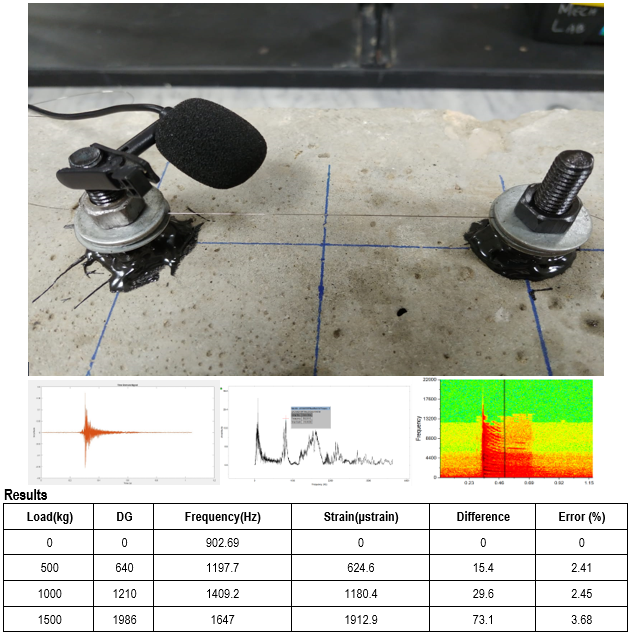
2021 - Analysis of a concrete bridge using BIM and 3D reconstruction Technique
Authors: Hamza Tariq, Mudassir Ahmad, Ghufran Ahmad, Waleed Afzal Khan
Abstract: Visual inspections are the initiating procedures for any structural health assessment method. In civil engineering structures, visual inspections become more challenging because of the massiveness of the structures. In case of bridges, which are constantly exposed to dynamic loads (such as wind and traffic loads), the health inspection procedures involve heavy machinery which involves, disrupting the traffic flow. This research was aimed at addressing the said challenge by using Building Information modeling and 3D reconstruction technique, which not provide data for visual inspection, but also provides a 3D finite element model for static or dynamic analysis. During our field data collection, we identified the constraints of carrying out the research (weather conditions). Geometric dimensions were measured as a reference for scaling the 3D model. A 4k camera mounted on a drone was used to acquire image data of the bridge using standard procedures (photogrammetry). However, due to difficulty in operating the drone in closed spaces, the procedure was supplemented by using a smartphone camera at those places. For 3D reconstruction, which is the process of acquiring a 3D model based on the raw data, 3DF Zephyr and Agisoft Metashape were used. The reconstruction process resulted in two components that make up the 3D Model: Point Cloud (a) and Mesh Model (b). Two types of models were developed i.e. the manual model as well as the automated model. The manual model(c) was traced by using the Point Cloud as a reference, drawing the BIM model of the bridge in Revit and then using it as a reference to make the structural model in Abaqus. The automated model(d) was generated by converting the texture mesh into a solid body and was imported directly in Abaqus. Both models were analyzed using 1D modal analysis after assigning material properties. The resulting dimensions acquired from the Photogrammetric method corresponded to actual dimensions of bridge and the result of the modal analysis matched with the reference paper which showed that 3d reconstruction has great potential in its applications in civil engineering.
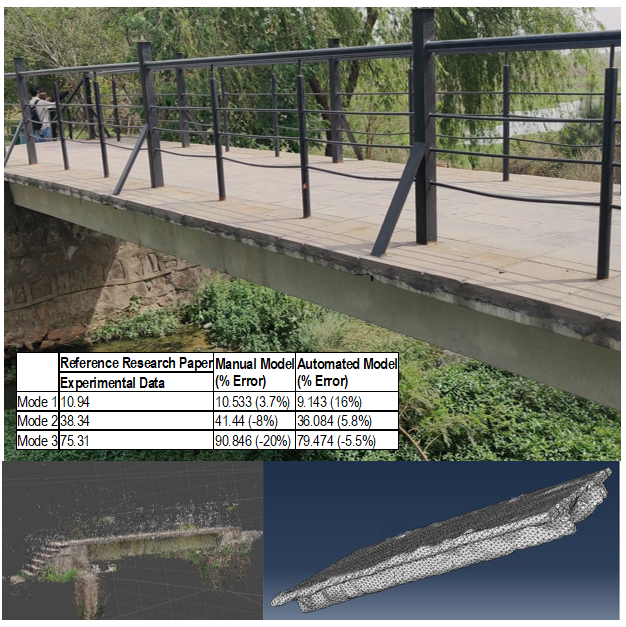
2021 - Development of Rapid Runway Repair Strategies Using Gene Expression Programming
Authors: Muhammad Mubeen, Hamza Naveed, Qudees Tariq Kayani
Abstract: The Airport infrastructure including approach runways, taxiways, and aprons is the most important and extremely sensitive target to be attacked by the enemy during warfare. Damage to airfield pavements from sophisticated enemy munitions threatens sustained aircraft sorties until the airfield is repaired. Bombing infuses large craters into the airfield infrastructures approaching 20 feet in width. Timely repair to immediately resume the flight operations is the topmost concern of the scenario. Numerous research in terms of materials, equipment, and techniques are globally practiced in the backfill of craters followed by the placement of crown as prefabricated modular elements or in-situ repair with rapid setting and rapid hardening grout. However, there are multiple associated parameters with local conditions that enforce an optimized solution for a particular site. The project aims to analyze all the available alternatives to extract an optimal solution for the restoration of airfields back on operational status following an enemy attack. In this study, Gene Expression Programming (GEP) was used to derive a predictive model of One-Day Compressive Strength of Rapid Hardening Concrete (RHC) mixes. The first objective of developing a database was achieved by doing an extensive literature review of the internationally published research studies. The database contains 115 different data points of 13 numerical variables. Randomly shuffled, 74% of the data was used for the training of the GEP model while the remaining 26% of data was utilized for the validation of the model. GeneXproTools 5.0 were used in our analysis. GEP Regression Analysis was used with function finding analysis in GeneXPro tools. Various quantitative and qualitative were observed during the analysis i.e., R-Squared Value, Mean Absolute Error (MAE), regression plot, residual plot, variable importance, etc. GEP was observed to be an excellent tool in evaluating and constructing statistical models for the compressive strength of RHC. The derived models can be used in the practical pre-planning phase and pre-design phase in terms of a wide range of cementitious materials, admixtures, and additives.

2020 - Finite element modeling of semi-rigid beam to column connection with partly hidden corbel
Author: Farooq Ahmed Athar
Abstract: Utilizing a large numbers of specimens in full-scaled experimental testing to study the behaviour of precast concrete connections can be expensive. An alternative is to cast and carry out a minimal number of experimental tests and then model the connection/structure in a finite element software. The FE model can be validated using the few experimental tests carried out, and FEA can be used to analyze and study the behaviour of the structure. Once validated, further parametric study can be carried out on the FE model. However, the modelling of precast concrete column-to-beam connection has not been explored widely by researchers. One of the main challenges is that modelling precast concrete connection involves complex surface to surface interaction and there is a lack of efficient ways on the modelling of the precast and in-situ concrete surface to surface interaction in finite element software. Hence, the main objective of this research is to model a hidden corbel precast beam-to-column connection in a finite element software, ABAQUS, which is then validated using the proposed precast connection and experimental works by Mokhtar (2017). Initially, the FE model was develop based on the technical drawings of the components and assembly of the precast connection. The FE model is validated when it can simulate similar structural behavior as the experimental tests. The behavior that were used for comparison with the experimental work is the moment–rotation, load–displacement, and the failure cracks patterns’ behavior. In general, the FE model results show similar behaviour with the experimental results, particularly on the load-displacement curve and failure cracks patterns. In addition, using the fixity factor, the connections were also classified as semirigid joint.

2020 - Analytical modeling of concrete cracking using fictitious crack model
Authors: Talha Naveed, Muhammad Jahangir, Ahmad Rehan Kashif
Abstract: Fictitious crack model is very suitable for modeling the fracture mechanism of concrete. This research adopts the fictitious crack model for analytical simulation of fracture mechanism of concrete. The iterative model was applied on developing moment-curvature of a reinforced concrete beam using a MATLAB code. Further efforts were made to transcribe the dynamic parameters using FCM

2019 - Developing a user-defined material model (UMAT) code for concrete modeling
Author: Loginy A/P Loganathan
Abstract: To perform and improve the material modelling of concrete, an existing Concrete Damaged Plasticity Model (CDPM) is incorporated into a simple concrete model in finite element software ABAQUS. The stress-strain graph of the model under compression is plotted. Then, a User-Defined Material (UMAT) coding is created using the same data and incorporated into the ABAQUS model to check the validity of the coding by plotting the same graph. Once the UMAT code is proven to be valid, the intermediate parameters and data will be modified to produce a smoother graph similar to the theoretical graph. Then, the new graph is validated using the theoretical graph. The accuracy of the ABAQUS modeling has been evaluated by comparing the stress-strain curves of the concrete proposed by Carreira and Chu to the corresponding one obtained from the numerical simulation using ABAQUS software. The verification of results show a well-agreement between the stress-strain curves of Carreira and Chu and analytical model. The significance of performing analysis on concrete using Concrete Damaged Plasticity Model is to predict formation of cracks in concrete beams under any kind of load and analyse the failure of concrete structures. As a result, cracks on beams in the future and at hidden places can be assessed. In conclusion, Concrete Damaged Plasticity Model is an easier and economical method to model concrete structures and assess its safety and functionality.
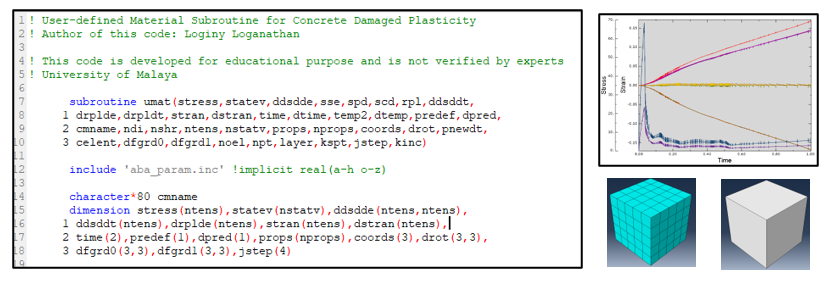
2017 - Damage detection in RC beams using finite element modeling
Author: Huan Xin Lim
Abstract: Concrete has been known as the most common construction material for civil engineering structures. Due to the complex mechanical properties of concrete, damage detection has become a great challenge for existing infrastructure. The structural health monitoring activities are performed to detect damage to mitigate risks, prevent disasters, and plan maintenance activities to ensure sufficient safety and reduce costs of repairs. Reinforced concrete (RC) consists of a combination of materials; concrete and reinforcing steel. This combination of materials makes the analysis of failure mechanisms more challenging. Therefore, there is a need to develop a damage detection method which can identify most of the damages in RC structures. The main objective of this research is to model and simulate damage in RC beam with the aid of finite element software, ABAQUS. In order to achieve this goal, material modelling was carried out. Concrete Damaged Plasticity (CDP) model was used to simulate failure of concrete beams. Static and dynamic analysis were simulated with the aid of ABAQUS. The validation of the numerical model was made through laboratory testing, including static and dynamic testing of RC beams. The relationships between load and deflection, damage level and natural frequency were discussed. The comparison between the results of the numerical model from ABAQUS and laboratory testing showed a similar trend in deflection and damage levels. Furthermore, an insight on non-linearities as damage indicators has been simulated. These damage indicators have been simulated and experimentally proved and have promising prospects in damage detection of structures without the need of baseline data.
